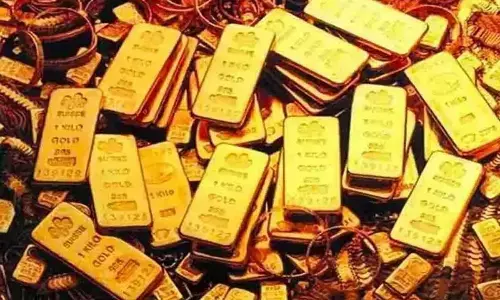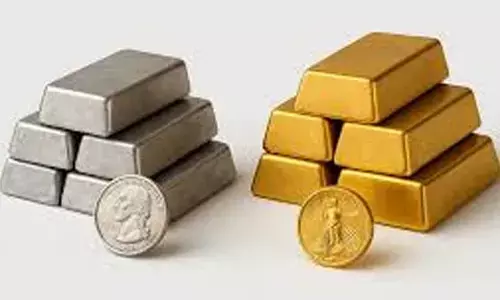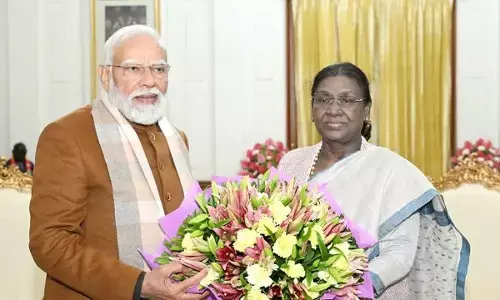Personality-centric Politics

Ever since Narendra Modi took over reins of power at centre, the discourse in Indian politics took a distinct turn. The role of personalities in India’s political history is re-interpreted and redefined. This is a part of his call for ‘Congress Mukt Bharat’ This is not accidental;
It may be Modi’s dream for ‘Congress Mukt Bharat’, his intention to de-link Patel from Congress or Sangh Parivar’s need for a symbol with larger appeal, there is a conscious projection of Sardar Patel as the hero of freedom struggle. The market forces, on the other hand, succeeded in convincing the nation to take to the capitalist path of development, marking the decline of Nehru’s image. However, as long as India as a Nation-State lasts, the contributions of both these personalities will constitute a part of collective memory for the people
Ever since Narendra Modi took over reins of power at centre, the discourse in Indian politics took a distinct turn. The role of personalities in India’s political history is re-interpreted and redefined. This is a part of his call for ‘Congress Mukt Bharat’ This is not accidental; it is logical fallout of what the Congress party has done to Nehruvian world- view under the leadership of Manmohan Singh aided and abetted by Chidambaram and Ahluvalia with implicit concurrence of Sonia Gandhi.
.jpg)
This was negation of all that Congress party promised to the people of India during the freedom struggle and what Jawaharlal Nehru stood for. The Congress, in fact, was a Movement representing varied shades and ideological inclinations of National life. The party included persons and personalities of varied political positions of which Nehru and Patel represented different ideological positions and approach to politics itself. Nehru represented left of the centre and Patel the right. Yet a broad consensus was reached in the course of constitution making. Normally constitutions deal with legal framework, but Indian constitution provided a vision and contours of the social order that was to be created. Sardar Patel, by no accounts, disagreed with that vision.
The Congress party being a multi-class multi- caste conglomeration, it was never able to uphold a clear ideological position as ideology is a function of a class. It is one of those historical puzzles that Gandhi had huge following but not of Gandhian ideology. The present projection of Sardar Patel as a hero of freedom struggle by Modi and his ilk is to completely disconnect Patel from the Congress Party. It is also consciously ignored that Patel was a member of Nehru’s cabinet till his death. Both were followers of Gandhi and both had equal respect for Gandhi. It is because of ideological ambiguity; Nehru represented something called left of the centre and Patel right of the centre.
Nehru was shaped by western liberal values and chose celebration of pluralism as a path for Nation-Building. He was also product of composite Indian culture. Being a reasonably good student of history, he discovered unity in diversity and admixture of tradition and modernity. Patel, in contrast, was a man of action and determination. His world view is drawn from entrepreneurial culture of the then Bombay Presidency. He successfully integrated more than 500 princely states by hook or crook. VP Menon brought out role of Patel in this historical process very elaborately in his book on Integration of Indian States. As long as India as a Nation-State lasts, the Contribution of both these personalities will constitute a part of collective memory of the people.
.jpg)
Singling out Patel for special honor by Modi and his friends has something more than the eye can see. Sangh Parivar although founded in 1920s was not a part of the freedom struggle, but now being a ruling class to hold on to power and combat a Party like congress it does need symbols. The Parivar does have some symbols which do not have a larger appeal as yet. This void in their politics is sought to be filled by appropriating symbols which do not legitimately belong to them. One of the cited reasons for the gratitude of Parivar is that Patel did not fully agree with Nehru on banning the RSS after the assassination of Gandhi. Another reason that gravitates Parivar to Patel is his attitude and approach to minorities particularly muslims. It is widely believed, without much of substantial evidence, that Patel was tough with the minorities. The one example given is annexation of Hyderabad State with Indian Union and after the annexation Nehru personally went to see the Nizam, whereas Patel insisted that Nizam receive him at the airport.
More than these reasons, the Nehruvian model, it was believed, accounted for slow growth and the entire developmental structures and State regulation were come to be considered as bottle-necks for further growth. The market forces buttresses by the global capital, vociferously supported by the corporate media succeeded in manufacturing the consent of the vocal middle class that the nation should take to capitalist path of development for a breakthrough. This marks the beginning of decline of image of Nehru.
This paved the way for rise of the right wing politics. The Congress party solely responsible for this shift which robbed the party of its earlier image as party of left of the centre and its stance for welfare and distributive Justice was taken a beating. The Congress left with no political route to go for mass mobilization which Mrs. Gandhi was able to do. It is in this void right wing politics entered, entered through cultural route.
The so called ‘growth model’ triggered by the imperialist forces became the forte of the Bharatiya Janata Party which enjoyed the support of RSS which developed huge network across different parts of India. RSS has its own world-view, propaganda machinery, committed cadres, which no other political party in India possesses at this point of time. The combination of these formidable forces smoothly took over the ‘growth model’ initiated by Narsimha Rao and Manmohan Singh with additional advantage of well built organisational structure. The overthrow of Nehruvian model by the congress Party itself left the Party direction-less and reduced it to a party of no consequence as of now.
The politics of the Bharatiya Janata Party or its earlier incarnation Jana Sangh rooted essentially in cultural nationalism, that is the strength and weakness too.The strength is that it found a safe cultural root to masses invoking past memories, surviving cultural modes without any promising any alternative economic and political order for future.
.jpg)
The weakness being that it cannot wipe out the memory of the freedom struggle with which Nehru’s name is closely associated. There is no way that it can disown this past. Invoking the image of Sardar Patel and condemning Nehruis product of this dilemma. This is also personal need of Modi to consolidate his power with Patels of Gujarat whom he has marginalised in the State power structure.
Ideologically Patel fits into the BJP framework; it became all the easier as Nehruvian approach and Nehru were rendered irrelevant. Patel was both tough and action oriented at one level and right wing wala at another level. It is also true that Nehruvian Parivar overemphasised on Nehru’s image and not his world-view. If Congress has overthrown Nehruvian ideology, Narendra Modi is overthrowing Nehru. Since the BJP has no symbols associated with the freedom movement, they are appropriating Patel without much of protest from the Congress party. Nehru-Patel controversy is not only of personalities but of the very foundational values of Indian Constitution.
(The writer is an eminent activist, a National Fellow, Tata Institute of Social Sciences)



















